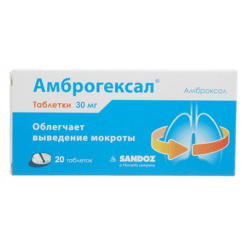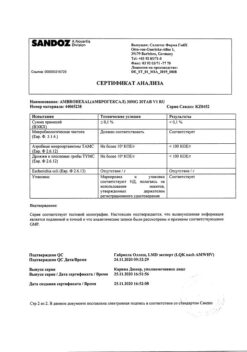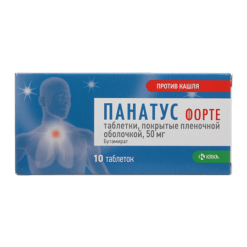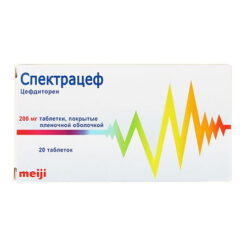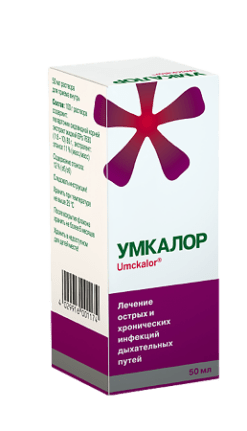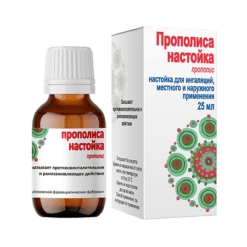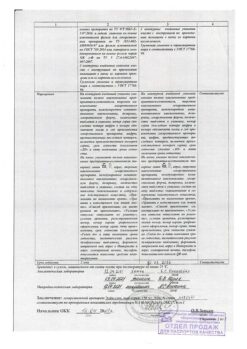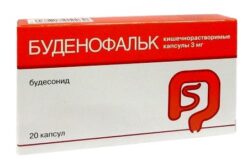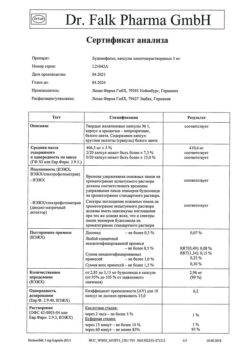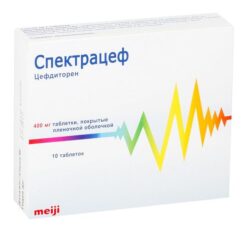No products in the cart.
Ambrohexal, 6 mg/ml syrup 100 ml
€1.00
Out of stock
(E-mail when Stock is available)
Description
Pharmacodynamics
Has secretomotor, secretolytic and expectorant action, stimulates serous glandular cells of the bronchial mucosa, increases the mucous secretion and release of surfactant (surfactant) in the alveoli and bronchi, normalizes the disturbed ratio of serous and mucous components of sputum.
By activating hydrolyzing enzymes and increasing the release of lysosomes from the clara cells, reduces the viscosity of sputum. Increases the motor activity of the atrial epithelium, increases mucociliary transport, facilitates the expulsion of sputum from the airways.
On average, the effect when ambroxol is taken orally occurs within 30 minutes and lasts 6-12 hours, depending on the size of the single dose.
Pharmacokinetics
Ambroxol after oral administration is quickly and almost completely absorbed.
Time to maximum concentration (TSmax) after oral administration is reached after 1-3 hours.
Metabolized in the liver with the formation of metabolites, excreted through the kidneys (dibromanthranilic acid, glucuronides).
Binding with blood plasma proteins is approximately 85%.
Half-life period (T1/2) from blood plasma is 7-12 hours. T1/2 of ambroxol and its metabolites is approximately 22 hours. Through the kidneys 90% of ambroxol is excreted in the form of metabolites. Less than 10% of ambroxol is excreted unchanged through the kidneys.
Due to high protein binding and large volume of distribution, as well as slow reverse penetration from tissues into blood, during dialysis or forced diuresis there is no significant ambroxol excretion. Ambroxol clearance in patients with severe hepatic impairment is reduced by 20-40%.
In severe renal failure half-life of ambroxol metabolites is increased. Ambroxol penetrates through the placental barrier and into the breast milk.
Indications
Indications
Acute and chronic diseases of the respiratory tract, accompanied by the formation of viscous secretions:
acute and chronic bronchitis;
bronchiectasis;
bronchial asthma;
bronchiolitis;
cystic fibrosis;
rhinitis, sinusitis.
Pharmacological effect
Pharmacological effect
Pharmacodynamics
It has a secretomotor, secretolytic and expectorant effect, stimulates the serous cells of the glands of the bronchial mucosa, increases the content of mucous secretion and the release of surfactant in the alveoli and bronchi, normalizes the disturbed ratio of serous and mucous components of sputum.
By activating hydrolyzing enzymes and enhancing the release of lysosomes from Clara cells, it reduces the viscosity of sputum. Increases the motor activity of the ciliated epithelium, increases mucociliary transport, facilitates the removal of sputum from the respiratory tract.
On average, the effect of taking ambroxol orally occurs within 30 minutes and lasts 6-12 hours, depending on the size of the single dose.
Pharmacokinetics
Ambroxol after oral administration is quickly and almost completely absorbed.
The time to reach maximum concentration (TCmax) after oral administration is achieved within 1-3 hours.
Metabolized in the liver to form metabolites excreted through the kidneys (dibromanthranilic acid, glucuronides).
Plasma protein binding is approximately 85%.
The half-life (T1/2) from blood plasma is 7-12 hours. T1/2 of ambroxol and its metabolites is approximately 22 hours. 90% of ambroxol in the form of metabolites is excreted through the kidneys. Less than 10% of ambroxol is excreted unchanged through the kidneys.
Due to high protein binding and a large volume of distribution, as well as slow re-penetration from tissues into the blood, significant elimination of ambroxol does not occur during dialysis or forced diuresis. The clearance of ambroxol in patients with severe liver failure is reduced by 20-40%.
In severe renal failure, the half-life of ambroxol metabolites increases. Ambroxol penetrates the placental barrier and into breast milk.
Special instructions
Special instructions
Ambroxol should not be taken simultaneously with antitussive drugs that can inhibit the cough reflex, such as codeine, because this may make it difficult to clear thin mucus from the airways. Ambrohexal® should be used with caution in patients with a weakened cough reflex or impaired mucociliary transport due to the possibility of sputum accumulation.
Patients taking ambroxol should not be advised to perform breathing exercises; in seriously ill patients, aspiration of liquefied sputum should be performed.
In patients with bronchial asthma, ambroxol may increase cough.
You should not take ambroxol immediately before bed.
Instructions for diabetics: 1 measuring spoon (5 ml of syrup) contains 1.75 g of sorbitol (less than 0.15 XE).
Active ingredient
Active ingredient
Ambroxol
Composition
Composition
5 ml of syrup contains:
Active substance:
ambroxol hydrochloride 15 mg;
Excipients:
benzoic acid;
citric acid;
glycerol;
sodium cyclamate;
sodium hydroxide;
sodium metabisulfite;
polyvidone; sorbitol;
purified water;
flavorings.
Pregnancy
Pregnancy
The drug is contraindicated for use during the first trimester of pregnancy.
The use of Ambrohexal® during pregnancy (II-III trimester) is possible only if the expected benefit to the mother outweighs the potential risk to the fetus.
Ambroxol penetrates the placental barrier. Animal studies have shown that the drug has no effect on embryofetal development, childbirth and postnatal development.
Ambroxol is excreted in small quantities into breast milk, therefore, when taking Ambrohexal®, it is necessary to decide whether to stop breastfeeding.
Contraindications
Contraindications
Hypersensitivity to ambroxol and other components of the dosage forms of the drug.
Side Effects
Side Effects
According to the World Health Organization (WHO), adverse effects are classified according to their frequency as follows: very common (≥1/10), common (≥1/100 to <1/10), uncommon (≥1/1,000 to <1/100), rare (≥1/10,000 to <1/1,000), very rare (< 1/10,000); frequency unknown - based on available data, it was not possible to determine the frequency of occurrence.Allergic reactions
rarely: skin rash, urticaria;
frequency unknown: anaphylactic reactions, including anaphylactic shock, angioedema, pruritus and other hypersensitivity reactions.
From the gastrointestinal tract
often: nausea;
uncommon: heartburn, vomiting, diarrhea, dyspepsia and abdominal pain.
From the nervous system
often: changes in taste sensations.
Other
often: decreased sensitivity in the mouth or pharynx;
uncommon: dry mouth;
frequency unknown: dry mucous membranes of the respiratory tract.
Interaction
Interaction
Combined use with antitussive drugs leads to difficulty in sputum discharge due to suppression of the cough reflex. Increases the penetration of amoxicillin, cefuroxime, erythromycin and doxycycline into the bronchial secretions.
Overdose
Overdose
Symptoms: nausea, vomiting, gastralgia. There are reports of short-term anxiety and diarrhea. In case of severe overdose, blood pressure may drop.
Treatment: induction of vomiting, gastric lavage in the first 1–2 hours after taking the drug, administration of fat-containing foods.
Storage conditions
Storage conditions
The drug should be stored at a temperature not exceeding 25°C. The drug in syrup form should be stored in a place protected from light.
Shelf life
Shelf life
2 years.
Manufacturer
Manufacturer
Lichtenheldt GmbH Pharmaceuticals Factory, Germany
Additional information
| Shelf life | 2 years. |
|---|---|
| Conditions of storage | The drug should be stored at a temperature not higher than 25°C. The drug in syrup form should be stored in a light-protected place. |
| Manufacturer | Lichtenheldt GmbH Pharmazoitische Fabrik, Germany |
| Medication form | syrup |
| Brand | Lichtenheldt GmbH Pharmazoitische Fabrik |
Other forms…
Related products
Buy Ambrohexal, 6 mg/ml syrup 100 ml with delivery to USA, UK, Europe and over 120 other countries.


